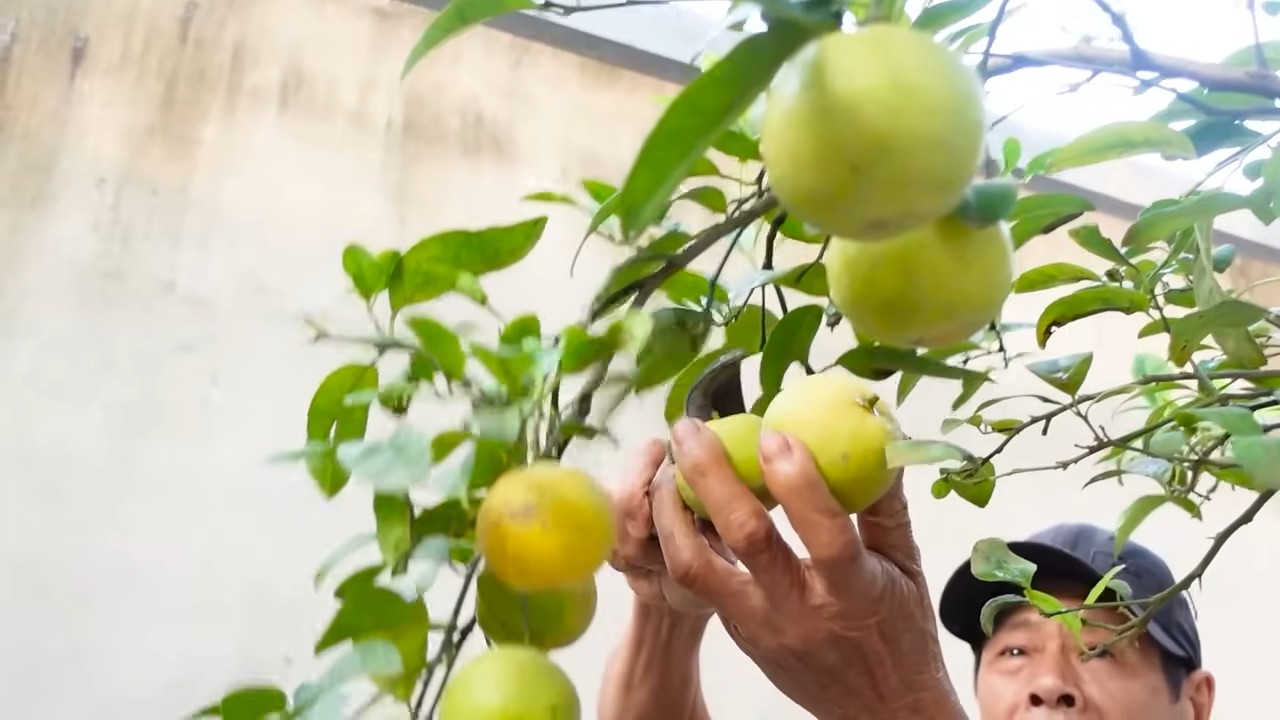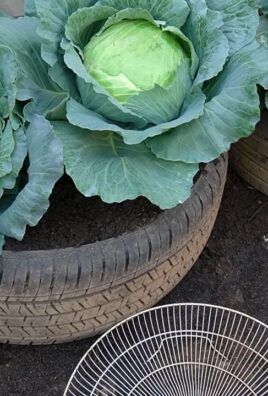Grow lemons year round? Imagine stepping outside your back door in the dead of winter and plucking a sun-kissed lemon, bursting with flavor, straight from your own tree! Sounds like a dream, right? Well, it doesn’t have to be! For centuries, citrus fruits have been prized for their vibrant taste and health benefits, playing a significant role in cuisines and cultures around the globe. From ancient Roman gardens to modern-day Mediterranean orchards, the allure of fresh lemons has endured.
But what if you don’t live in a sunny, warm climate? That’s where these amazing DIY tricks and hacks come in! Many people believe that growing lemons is only possible in tropical or subtropical regions, but I’m here to tell you that with a little know-how, you can grow lemons year round, no matter where you live. This article is packed with simple, effective techniques to help you cultivate your own thriving lemon tree, even indoors.
Why is this so important? Because store-bought lemons can be expensive and often lack the intense flavor of homegrown fruit. Plus, there’s nothing quite like the satisfaction of nurturing a plant from seedling to harvest. Get ready to unlock the secrets to year-round lemon abundance and enjoy the freshest, most flavorful lemons you’ve ever tasted!

Zitronen das ganze Jahr über selbst anbauen: Ein umfassender DIY-Leitfaden
Hallo liebe Gartenfreunde! Habt ihr euch jemals gewünscht, das ganze Jahr über frische, saftige Zitronen direkt von eurem eigenen Baum pflücken zu können? Ich auch! Und nach einigem Experimentieren und Lernen habe ich herausgefunden, wie man das möglich macht. Dieser Artikel ist euer umfassender Leitfaden, um Zitronen das ganze Jahr über anzubauen, egal wo ihr wohnt. Lasst uns eintauchen!
Die Grundlagen: Was ihr braucht
Bevor wir loslegen, lasst uns sicherstellen, dass wir alles haben, was wir brauchen. Hier ist eine Liste der wichtigsten Dinge:
* Ein Zitronenbaum: Wählt eine Sorte, die für den Anbau im Topf geeignet ist, wie z.B. ‘Meyer’ oder ‘Improved Meyer’. Diese Sorten sind kompakter und tragen tendenziell früher Früchte.
* Ein großer Topf: Der Topf sollte mindestens 50 cm Durchmesser haben und über gute Drainagelöcher verfügen.
* Hochwertige Blumenerde: Verwendet eine gut durchlässige Blumenerde, die speziell für Zitrusfrüchte entwickelt wurde. Vermeidet Gartenerde, da diese zu schwer ist und die Wurzeln ersticken kann.
* Dünger: Ein Zitrusdünger ist unerlässlich, um eurem Baum die Nährstoffe zu geben, die er zum Wachsen und Fruchten benötigt.
* Wasser: Regelmäßiges Gießen ist wichtig, besonders während der Wachstumsperiode.
* Sonnenlicht: Zitronenbäume lieben die Sonne! Stellt sicher, dass euer Baum mindestens 6-8 Stunden direktes Sonnenlicht pro Tag bekommt.
* Schnittwerkzeug: Eine scharfe Gartenschere ist wichtig, um euren Baum zu beschneiden und tote oder kranke Äste zu entfernen.
* Pflanzenschutzmittel: Haltet Ausschau nach Schädlingen und Krankheiten und habt ein geeignetes Pflanzenschutzmittel zur Hand.
* Geduld: Zitronenbäume brauchen Zeit, um zu wachsen und Früchte zu tragen. Seid geduldig und gebt nicht auf!
Schritt-für-Schritt-Anleitung: Zitronenbaum pflanzen und pflegen
Jetzt, da wir alles haben, was wir brauchen, können wir mit dem Pflanzen und Pflegen unseres Zitronenbaums beginnen.
1. Den richtigen Topf auswählen: Wie bereits erwähnt, ist ein großer Topf mit guter Drainage entscheidend. Ich empfehle einen Topf aus Terrakotta oder Kunststoff mit einem Durchmesser von mindestens 50 cm. Stellt sicher, dass der Topf Drainagelöcher hat, damit überschüssiges Wasser ablaufen kann.
2. Den Baum vorbereiten: Bevor ihr den Baum in den Topf pflanzt, solltet ihr ihn vorsichtig aus seinem ursprünglichen Behälter nehmen. Lockert die Wurzeln vorsichtig auf, um sicherzustellen, dass sie sich im neuen Topf gut ausbreiten können. Wenn die Wurzeln stark verwurzelt sind, könnt ihr sie vorsichtig mit einer sauberen Gartenschere beschneiden.
3. Den Baum pflanzen: Füllt den Topf mit einer Schicht Blumenerde. Setzt den Baum in die Mitte des Topfes und füllt den restlichen Raum mit Blumenerde auf. Achtet darauf, dass der Wurzelballen des Baumes mit der Oberseite des Topfes abschließt. Drückt die Erde leicht an, um den Baum zu stabilisieren.
4. Gießen: Gießt den Baum gründlich, bis das Wasser aus den Drainagelöchern abläuft. Dies hilft, die Erde zu setzen und die Wurzeln zu befeuchten.
5. Standort wählen: Zitronenbäume lieben die Sonne! Stellt euren Baum an einen sonnigen Standort, an dem er mindestens 6-8 Stunden direktes Sonnenlicht pro Tag bekommt. Wenn ihr in einem Gebiet mit kalten Wintern lebt, solltet ihr den Baum in einen Topf pflanzen, damit ihr ihn im Winter ins Haus holen könnt.
6. Düngen: Düngt euren Zitronenbaum regelmäßig mit einem Zitrusdünger. Befolgt die Anweisungen auf der Verpackung, um die richtige Menge Dünger zu verwenden. Ich dünge meinen Baum alle 4-6 Wochen während der Wachstumsperiode (Frühling und Sommer) und reduziere die Düngung im Herbst und Winter.
7. Gießen: Gießt euren Zitronenbaum regelmäßig, besonders während der Wachstumsperiode. Die Erde sollte feucht, aber nicht durchnässt sein. Lasst die Erde zwischen den Wassergaben leicht antrocknen. Im Winter benötigt der Baum weniger Wasser.
8. Beschneiden: Beschneidet euren Zitronenbaum regelmäßig, um seine Form zu erhalten und das Wachstum neuer Früchte zu fördern. Entfernt tote, kranke oder sich kreuzende Äste. Beschneidet den Baum im späten Winter oder frühen Frühling, bevor das neue Wachstum beginnt.
9. Schädlingsbekämpfung: Haltet Ausschau nach Schädlingen wie Blattläusen, Schildläusen und Spinnmilben. Wenn ihr Schädlinge entdeckt, behandelt sie mit einem geeigneten Pflanzenschutzmittel. Ich verwende gerne eine Mischung aus Wasser und Spülmittel, um Schädlinge zu bekämpfen.
10. Überwintern: Wenn ihr in einem Gebiet mit kalten Wintern lebt, müsst ihr euren Zitronenbaum im Winter ins Haus holen. Stellt den Baum an einen hellen, kühlen Ort, wie z.B. ein sonniges Fenster oder einen Wintergarten. Reduziert die Bewässerung und Düngung während des Winters.
Zusätzliche Tipps für eine erfolgreiche Zitronenernte
Hier sind noch ein paar zusätzliche Tipps, die euch helfen können, eine erfolgreiche Zitronenernte zu erzielen:
* Bestäubung: Zitronenbäume sind selbstbestäubend, aber ihr könnt die Bestäubung verbessern, indem ihr die Blüten mit einem kleinen Pinsel bestäubt. Dies ist besonders wichtig, wenn der Baum im Haus steht, wo es weniger Insekten gibt, die die Bestäubung übernehmen können.
* Luftfeuchtigkeit: Zitronenbäume bevorzugen eine hohe Luftfeuchtigkeit. Wenn die Luft in eurem Haus trocken ist, könnt ihr die Luftfeuchtigkeit erhöhen, indem ihr den Baum regelmäßig besprüht oder ihn in der Nähe eines Luftbefeuchters aufstellt.
* Umtopfen: Umtopfen ist wichtig, um sicherzustellen, dass euer Baum genügend Platz zum Wachsen hat. Topft den Baum alle 2-3 Jahre in einen größeren Topf um.
* Boden testen: Testet den pH-Wert des Bodens regelmäßig. Zitronenbäume bevorzugen einen leicht sauren Boden mit einem pH-Wert zwischen 6,0 und 7,0.
* Geduld: Zitronenbäume brauchen Zeit, um zu wachsen und Früchte zu tragen. Seid geduldig und gebt nicht auf! Es kann einige Jahre dauern, bis euer Baum Früchte trägt, aber es lohnt sich!
Häufige Probleme und Lösungen
Auch wenn ihr alles richtig macht, können bei der Zitronenzucht Probleme auftreten. Hier sind einige häufige Probleme und wie ihr sie lösen könnt:
* Gelbe Blätter: Gelbe Blätter können ein Zeichen für Überwässerung, Unterwässerung, Nährstoffmangel oder Schädlingsbefall sein. Überprüft die Erde, um festzustellen, ob sie zu feucht oder zu trocken ist. Düngt den Baum mit einem Zitrusdünger, um Nährstoffmangel zu beheben. Untersucht den Baum auf Schädlinge und behandelt sie gegebenenfalls.
* Fruchtfall: Fruchtfall kann durch Stress, Überwässerung, Unterwässerung, Nährstoffmangel oder Temperaturschwankungen verursacht werden. Stellt sicher, dass der Baum ausreichend Wasser und Nährstoffe erhält. Vermeidet es, den Baum plötzlichen Temperaturschwankungen auszusetzen.
* Keine Früchte: Wenn euer Baum keine Früchte trägt, kann dies an mangelndem Sonnenlicht, falscher Düngung oder fehlender Bestäubung liegen. Stellt sicher, dass der Baum mindestens 6-8 Stunden direktes Sonnenlicht pro Tag bekommt. Düngt den Baum mit einem Zitrusdünger, der reich an Phosphor ist. Bestäubt die Blüten mit einem kleinen Pinsel, um die Bestäubung zu verbessern.
Zitronensorten für den Anbau im Topf
Nicht alle Zitronensorten eignen sich für den Anbau im Topf. Hier sind einige Sorten, die sich gut für den Anbau im Topf eignen

Conclusion
So, there you have it! Growing lemons year-round might seem like a citrusy dream reserved for sun-drenched orchards, but with this simple DIY trick, it’s an achievable reality, even if you live in a climate that experiences frosty winters. We’ve demystified the process, breaking down the steps to create a microclimate that fosters lemon growth regardless of the season. This isn’t just about having fresh lemons on hand; it’s about connecting with nature, nurturing life, and experiencing the satisfaction of harvesting your own fruit.
This method offers a significant advantage over relying solely on seasonal growth. Imagine the joy of adding a slice of homegrown lemon to your winter tea, or using freshly squeezed juice in your holiday baking. No more trips to the grocery store for overpriced, often lackluster lemons! You’ll have a constant supply of vibrant, flavorful fruit right at your fingertips.
But the benefits extend beyond convenience. By controlling the environment around your lemon tree, you’re also protecting it from harsh weather conditions, pests, and diseases. This leads to a healthier, more productive tree, and ultimately, a more abundant harvest. Plus, you’re reducing your carbon footprint by eliminating the need for transportation and storage associated with commercially grown lemons.
Why is this DIY trick a must-try? Because it empowers you to take control of your lemon supply, regardless of your location or the time of year. It’s a sustainable, cost-effective, and incredibly rewarding way to enjoy the taste of sunshine all year long.
Don’t be afraid to experiment! Consider these variations to personalize your lemon-growing experience:
* Variety Selection: Different lemon varieties have varying levels of cold hardiness. Research which varieties are best suited for your specific climate. Meyer lemons, for example, are known for their tolerance to cooler temperatures.
* Container Size: As your lemon tree grows, you may need to upgrade to a larger container. Ensure the container has adequate drainage to prevent root rot.
* Lighting: If you live in a particularly dark climate, consider supplementing natural light with grow lights, especially during the winter months.
* Fertilizing: Regularly fertilize your lemon tree with a citrus-specific fertilizer to provide it with the nutrients it needs to thrive. Follow the instructions on the fertilizer packaging carefully.
* Grafting: For faster fruit production, consider purchasing a grafted lemon tree. Grafting combines the desirable traits of two different lemon varieties.
We’re confident that you’ll find this DIY trick to be a game-changer in your lemon-growing journey. It’s a simple, effective, and incredibly satisfying way to enjoy the taste of homegrown lemons year-round.
So, what are you waiting for? Gather your supplies, follow our instructions, and embark on your own lemon-growing adventure. We encourage you to try this DIY trick and share your experiences with us! Let us know how it works for you, what challenges you encounter, and what successes you celebrate. Share your photos, tips, and tricks in the comments section below. We can’t wait to hear from you and learn from your experiences. Together, we can create a community of year-round lemon growers!
Frequently Asked Questions (FAQ)
What type of lemon tree is best for growing indoors or in a controlled environment?
Meyer lemon trees are often recommended for indoor growing due to their smaller size and tolerance of cooler temperatures. They also tend to fruit more readily than other varieties. However, other dwarf varieties like ‘Improved Meyer’ or ‘Ponderosa’ can also be suitable. Research the specific needs of each variety to ensure it aligns with your growing conditions. Consider the amount of sunlight your space receives and the average temperature.
How much sunlight does my lemon tree need when growing indoors?
Lemon trees need at least 6-8 hours of direct sunlight per day to thrive. If you’re growing your tree indoors, place it near a south-facing window where it can receive the most sunlight. If natural light is insufficient, supplement with grow lights. LED grow lights are energy-efficient and provide the full spectrum of light that plants need for photosynthesis. Position the grow lights about 6-12 inches above the tree’s foliage.
What kind of soil should I use for my lemon tree?
Lemon trees prefer well-draining, slightly acidic soil. A potting mix specifically formulated for citrus trees is ideal. You can also create your own mix by combining equal parts of potting soil, perlite, and peat moss. Perlite improves drainage, while peat moss helps retain moisture. Avoid using garden soil, as it can be too heavy and may not drain well.
How often should I water my lemon tree?
Water your lemon tree when the top inch of soil feels dry to the touch. Water deeply until water drains out of the drainage holes in the bottom of the pot. Avoid overwatering, as this can lead to root rot. During the winter months, when the tree is not actively growing, you may need to water less frequently. Check the soil moisture regularly and adjust your watering schedule accordingly.
What kind of fertilizer should I use for my lemon tree?
Use a citrus-specific fertilizer that contains essential nutrients like nitrogen, phosphorus, and potassium, as well as micronutrients like iron, zinc, and manganese. Follow the instructions on the fertilizer packaging carefully. Fertilize your lemon tree regularly during the growing season (spring and summer), typically every 4-6 weeks. Reduce or stop fertilizing during the winter months.
How do I protect my lemon tree from pests and diseases?
Inspect your lemon tree regularly for signs of pests and diseases. Common pests include aphids, spider mites, and scale. Treat infestations promptly with insecticidal soap or neem oil. Ensure good air circulation around the tree to prevent fungal diseases. Prune away any dead or diseased branches. If you notice any unusual symptoms, consult with a local nursery or agricultural extension office for advice.
How do I prune my lemon tree?
Prune your lemon tree in late winter or early spring, before new growth begins. Remove any dead, damaged, or crossing branches. Prune to maintain a desired shape and size. You can also prune to encourage fruit production by removing water sprouts (vigorous, non-fruiting shoots). Use clean, sharp pruning shears to make clean cuts.
How do I pollinate my lemon tree indoors?
Lemon trees are self-pollinating, but indoor trees may benefit from hand-pollination. Use a small paintbrush or cotton swab to transfer pollen from the stamen (male part) to the pistil (female part) of each flower. Repeat this process every few days during the flowering period. You can also gently shake the tree to help distribute pollen.
What are the signs that my lemon tree is not thriving?
Signs that your lemon tree is not thriving include yellowing leaves, leaf drop, stunted growth, and lack of fruit production. These symptoms can be caused by a variety of factors, including improper watering, insufficient sunlight, nutrient deficiencies, pests, or diseases. Diagnose the problem carefully and take appropriate action to correct it.
Can I really grow lemons year-round using this DIY trick?
Yes, with proper care and attention, you can successfully grow lemons year-round using this DIY trick. By creating a controlled environment, you can protect your lemon tree from harsh weather conditions and provide it with the optimal growing conditions it needs to thrive. Remember to monitor your tree regularly and adjust your care routine as needed. The key is consistency and attention to detail.




Leave a Comment